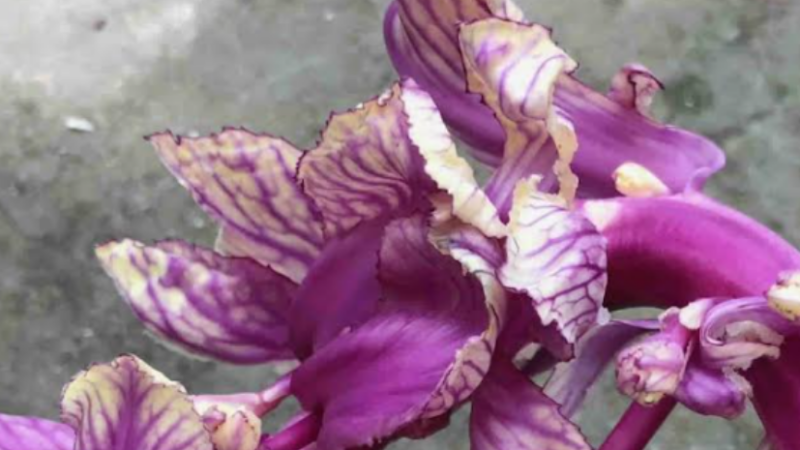How to Bloom in the Dark: Self-Compassion, Compost, and Nature
Compassion is the magic ingredient that turns our personal “compost” into personal evolution.
Some time ago, I found a strange bloom in the kitchen. It was elegantly twisted, like a dragon at a Chinese New Year celebration. It was frilled, purple, and pungent. This exquisite thing grew out of a chunk of purple cabbage that I’d put under the sink to go out for compost. Instead of fading quietly however, it burst into new life in the dark grotto of my cabinetry. It blossomed into something unexpected, unusual, and fiercely beautiful.
Reflecting on the discovery of this “flower” in the shadows, I’m reminded of, and heartened by, the fertility of dark times. Many people are feeling a collective spiritual darkness now, exhausted and frustrated, maybe also angry and scared. Having compassion for ourselves and others is especially important in times of literal and metaphorical darkness. How can we do this if we already feel overloaded?
Nature is our ultimate model and guide—in the light, in the dark, and in the most surprising and gorgeous ways. Cue the weird, glorious cabbage flower which came to life in the dark. What was being shown there?
There is the clear compost metaphor. Compost is the stuff we reject, the moldy, wilted, too hard, too soft, nasty bits that don’t make it to the table. It’s also the leftovers from delicious things we appreciate and enjoy, silky mango skins, green tea leaves, dark coffee grounds.
It all transforms into a rich sloop that eventually nourishes future plants. Our personal work includes processing our own “dark” sides, the parts we’d like to hide or discard. Self-compassion (and compassion for others) holds both the rejected and respected parts of who we are. Like composting, it isn’t always pretty, but it’s potent. Research shows self-compassion helps us stay present and kindhearted without sinking into absorptive empathy, which can lead to overload and burnout. This meditation is part of the toolkit in the audio course Shining Bright Without Burning Out.
The cycles of the natural world, into which we are interwoven, take time. It’s hard to be patient, to let everything, both scorned and enjoyed, stew in our symbolic personal compost piles. The speed with which that brew changes from nasty to nourishing varies widely with the internal and external conditions. Sometimes all those different elements take a long time to dissolve and break down. Sometimes it turns around faster than we think possible, like time-lapse photography of a log rotting on the forest floor with new green shoots springing to life overnight. Compassion is the magic ingredient that turns our personal “compost” into personal evolution.
The dark supports transformation. Times of literal darkness are needed for regeneration. Roots, seeds, and bulbs prepare. People and animals sleep. Times of symbolic darkness are also helpful. In darkness, transformative processes happen without spectators, often below the level of our conscious awareness. These are periods of catharsis, healing after trauma, cocooning in preparation for the next version of ourselves and our world.
We sometimes feel hopeless and helpless in the dark. Our society avoids sinking into it. Instead, we gravitate towards purveyors of easy “love and light!” spirituality, shying away from the deep, gooey work that happens to the larval versions of ourselves (and those around us) when we’re in the darkness of the cocoon. Self-compassion is most needed when we’re a mess.
The dark is a vital part of the wheel of our days, our years, our lifetimes. We need it to survive and be healthy in the long term. So, let’s embrace it, explore it, and be gentle with ourselves as we confront our fear of it. From this darkness we are nourished to bloom into the light.
@ 2021 Mara Bishop MA
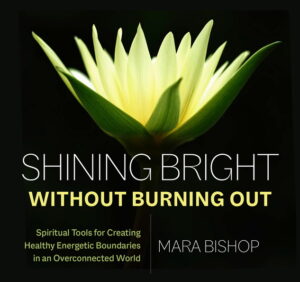 Order Shining Bright Without Burning Out now!
Order Shining Bright Without Burning Out now!
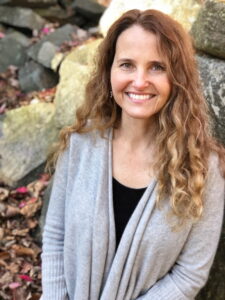
Mara Bishop has
over 25 years of experience helping people find spiritual health and
well-being. Her Personal Evolution Counseling™ method blends shamanism,
psychology, intuition, energy healing, and nature-based practices. She
lives in Durham, NC with a beloved family of people, animals, and
plants.
More information about Mara is at www.WholeSpirit.com
“Cranky” Is a Perfect Word
Dear Sounds True Friends,
“Cranky” is a perfect word. It feels like it sounds; the way it forms in your mouth fits the emotion. It’s perfect for that place between truly sad and properly angry, for times when we ought not to get so upset about trifling things, but we can’t help it. At least, not at first.
We’re allowed to be sad when hard times come. We’re allowed to be angry in the face of real injustice. But the papercuts of life? The whacked elbows and burnt toast, the stolen parking spots and somebody-took-the-last-cookie days? Not so much.
We’re supposed to take those moments in stride. We’re supposed to maintain our equilibrium. But moods are unruly and feelings don’t like to be bossed around. “Cranky” is the perfect word for those times when we feel resentful, irritated, and annoyed, but we know our cause isn’t especially sympathetic. When Murphy’s Law strikes, and we’re not yet ready to laugh it off.
I’m supposed to be patient and mature at times like these, but I can be a great big Crankypants. Knowing I’m not supposed to feel cranky only makes me more cranky. Next thing you know, I’m spiraling. (I’m probably the only one …)

Kids are no different. Life in families presents us all with nuisances and irritations. No one escapes a school day or a trip to the store unscathed. Life jostles us, but for kids, whose time and choices are largely directed by others, those feelings of powerlessness, of being managed and judged by someone who just doesn’t get it—and to be fair, sometimes we don’t get it; we weren’t there; we are quick to assume—those feelings can be maddening.
I wrote Cranky Right Now to give kids, parents, families, and teachers a way to talk about cranky times. and especially, a way to laugh about them. Illustrator extraordinaire Holly Hatam’s hilarious illustrations bring the magic. I hope you’ll giggle along with the vexed heroine of Cranky. It’s actually the first step forward. It’s easier to spot the absurdity in someone else’s cranky fit than our own, but the lessons still sink in. Humor is a powerful antidote to being a Crankypants.
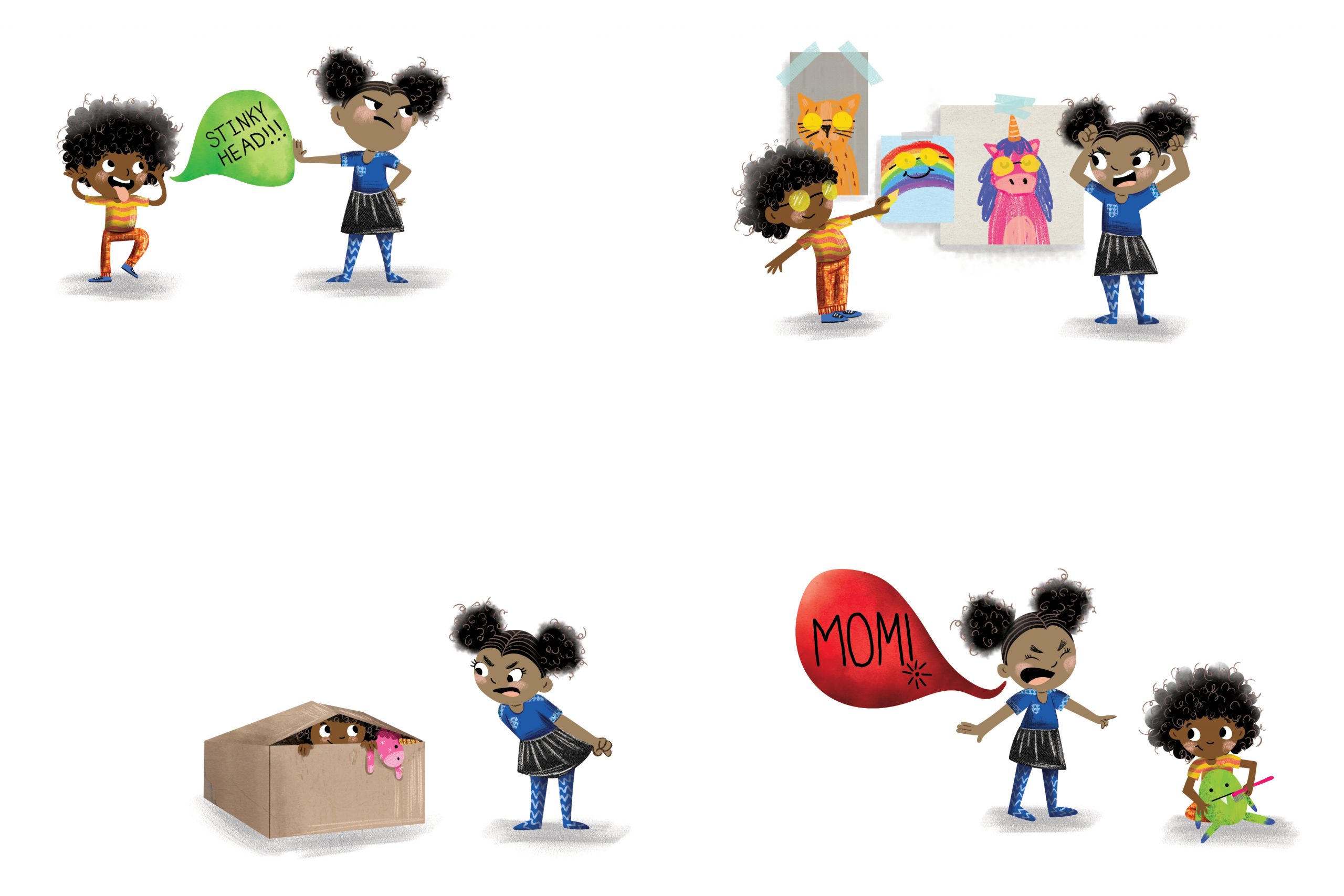
Sometimes simply having that perfect word, “cranky,” in our arsenal helps. When we can recognize, “Hey, I’m not actually deeply upset right now; everything’s more or less okay; I’m just cranky right now, and it will pass,” we’re already halfway home.
So get ready to giggle at the heroine of Cranky Right Now as she explores strategies for coping with crankiness. They may help the young people in your life. They may even help you. Not that you have a crankiness problem! Heavens, no. It’s those others around you. They started it …
Yours in absurdity,
Julie Berry
 JULIE BERRY is the author of many books for children, including Wishes and Wellingtons, The Scandalous Sisterhood of Prickwillow Place, and Happy Right Now. Her novel Lovely War was a New York Times bestseller, and The Passion of Dolssa was a Printz Honor title. Three things that make Julie cranky are paperwork, chewed pens and pencils, and mornings that come too soon. She lives with her family in Southern California. Learn more at julieberrybooks.com.
JULIE BERRY is the author of many books for children, including Wishes and Wellingtons, The Scandalous Sisterhood of Prickwillow Place, and Happy Right Now. Her novel Lovely War was a New York Times bestseller, and The Passion of Dolssa was a Printz Honor title. Three things that make Julie cranky are paperwork, chewed pens and pencils, and mornings that come too soon. She lives with her family in Southern California. Learn more at julieberrybooks.com.

Learn more and buy now
Amazon | Barnes & Noble | IndieBound | Bookshop | Sounds True
A Grounding Meditation to Start Living From Your Heart
I would like to open with a grounding meditation. Feel free to listen to the meditation here or you can read along with the text below.
If I may, I’d like to guide you someplace warm. To an island not too far away. It won’t take much effort, just a few conscious breaths. And all I need for you to do is to stop. For this moment, stop seeking, stop solving, stop gritting and grinding. All you need is to close your eyes and receive.
Quiet now, like water or sand. Settle now, like dusk and dew drop. One breath in, one breath out. One breath in, one breath out. Reorient yourself to face toward what is immovable inside you. Just look now. Trust and you shall see. It is there, to the left of your right lung, tucked just under your left rib, a warm small island, beating like a drum. If you stand here long enough, you will feel the song inside being written, maybe even prayed over you. Moment by moment, it never stops.
Can you feel you are unlacing something? Or better, something is unlacing you? Can you feel the fight stopping? The fear quieting? Can you feel your edges becoming more like wind or water, rather than shale and stone? Can you feel the light coming? The waves of warmth rising?
Now move into this current of grace that your heart has created for you, and feel the great hush wash over you. Feel the substance of love holding your very atoms together. This is your heart, dear one. Never forget this is yours. Kneel here, whenever you are thirsty, whenever your feet are tired, or your hands are sore. Kneel here when you can’t see love any longer. Kneel here, dear one. Reorient yourself toward what is immovable in you.
My new book, Heart Minded: How to Hold Yourself and Others in Love, was written to help remind us, reconnect us, reorient us with our hearts. Through story and guided meditation, I lead you through the fraught and sometimes frightening places holding you separate from your heart. It is a journey of healing that teaches you how to see and feel not from the mind, but from the wise seat of your very heart.
Now more than ever, we are being asked to move into the consciousness of the heart. Where love, compassion, “at-one-ment” become our governing virtues. When we see through the eyes of the heart, when we become heart minded, we stand as a beacon of light, burning back the dark.
Please join me in the heart-minded revolution.
This originally appeared as an author letter to the Sounds True audience from Sarah Blondin.
 Sarah Blondin is an internationally beloved spiritual teacher. Her guided meditations on the app InsightTimer have received nearly 10 million plays. She hosts the popular podcast Live Awake, as well as the online course Coming Home to Yourself. Her work has been translated into many languages and is in use in prison, recovery, and wellness programs. For more, visit sarahblondin.com.
Sarah Blondin is an internationally beloved spiritual teacher. Her guided meditations on the app InsightTimer have received nearly 10 million plays. She hosts the popular podcast Live Awake, as well as the online course Coming Home to Yourself. Her work has been translated into many languages and is in use in prison, recovery, and wellness programs. For more, visit sarahblondin.com.
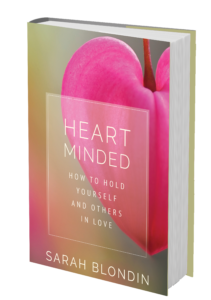
Learn More
Your original face
There is a famous Zen koan that asks, “What is your original face, the face you had before you were born?”
Whenever I have heard this koan, my first response is, “I have no idea how to answer that.” And of course, that is the purpose of a Zen koan, to confound the thinking mind and in so doing, wake us up to a deeper form of knowing.
One thing I have noticed is that the more I am able to sit in that not knowing state, to rest in a sense of “just being”, the more I can relax and feel what, if anything, is needed next. It is not a conceptual process; it is more like a listening. And from that listening, originality emerges (“original” meaning “from the origin” or “from the source”).
Waking up is not about copying anyone or anything. It can’t be. Because as soon as we are mimicking something, we are recycling someone else’s experience. We are one step removed from the source; we are no longer rooted in our own moment-to-moment revelatory experience.
My basic point here is that the more we discover our own Original Face, the face we had before we were born, the more confident we become in expressing ourselves in unique ways. In a sense, great spiritual teachers feel to me like great “artists of the spirit.” And like an inspired musician, poet, or painter, a spiritual artist knows that he or she must spend time in the space of not knowing and then trust the melodies, visions, words, and guidance that come through.
Sometimes people say to me that they are afraid of spiritual awakening because they are afraid of being erased, afraid that they will turn into a paste of nothingness. What I have found is that the more we drop the sense of being separate and disconnected, the more we tune to the underlying, unifying “hum” of being, the more we become plugged in to a current that begins to animate our life. And sometimes, the life force expresses through us in pretty outrageous ways. We take chances. We speak from our heart. We become a mystery to ourselves and a creative force in the world.
To take this even further, what if the more we discover our Original Face, the more our one-and-only physical face starts to express the love and beauty of the cosmos in unusual and distinctive ways? Abraham Lincoln is attributed with saying “Every man over 40 is responsible for his face.” I take this to mean that each one of us has a responsibility for the love and kindness and warmth and openness that our face communicates. What if the quality in our eyes, the shape of our mouth, the openness of our forehead, and even the character of our nose, is a direct expression of our capacity to know and rest in being?
At Sounds True, we often refer to the Wake Up Festival as a celebration of the “many faces of awakening.” And I love that phrase. I look forward to seeing each and every person’s one and only original face this August in the Rocky Mountains.

The Mystery of Holding
There is an ancient longing wired in us as infants to be seen, to be felt, and to have our surging, somatic-emotional world validated by another. When our subjective experience is empathically held, contained, and allowed, we come to a natural place of rest. What is love, really, other than fully allowing the other to be who they are, for their experience to be what it is, and to offer the gift of presence to their unique subjectivity? In this sense, I love you = I allow you.
The late Donald Winnicott, a brilliant psychoanalyst from Britain, used the term ‘holding environment’ to describe the ideal mandala in which growth and development could occur, weaved of the qualities of contact and space. Through making attuned, present-time, somatically-engaged contact with another as they are – and by providing an open, warm sanctuary in which their experience can unfold and illuminate – we become vehicles of love in action.
Simultaneously, by offering the gift of space, we do not interfere with the unfolding of their heart and majestic inner process. We do not pathologize their experience or demand that they be different, change, transform, shift, or ‘heal’ in order for us to love them. If sadness is there, or fear, or despair, or shame, or depression, or profound grief, we will infuse their inner mandala with validation and presence. We will be there for them, but only if they need us. We will not engulf them with the projections of our own unlived life, nor will we unload upon them our own requirements and agendas, arising out of our own undigested psyches and bodies. Instead, we will seed the intersubjective container with tender space.
While not talked about as much, we can provide this same contact and space to ourselves and come to discover that our nature as awareness itself is in fact the ultimate holding environment. You are always, already resting in the majesty of presence and are always, already held – by the beloved – who is none other than your own miracle nervous system, heart, and somatic brilliance. While we may not always understand our experience – and while it may never fit into our ideas, hopes, dreams, and fantasies about the life we were ‘meant to live’ – we can come to trust that it is unfolding according to a unique blueprint which is emerging out of the unseen hand of love. We are invited to practice a radical intimacy with our experience, staying close to our ripe bodies and tender hearts, but not so close that we fuse or overly identify with it. Rest in the very middle and stay astonished at what is being birthed out of the unknown in every moment.
For so many I speak with, there is an undercurrent of aggression towards themselves, a subtle movement of self-loathing, unexamined shame and embarrassment, and a very alive (if not conscious) belief that they are flawed and have failed. Each time we exit our present, embodied experience into thinking, interpretation, blame, resentment, and complaint, we turn from the preciousness and the majesty of what we are. In this movement of rejection, we keep alive the archaic belief that our immediate experience is not valid, that it is not workable, that it is not forming the actual particles of the path of healing, exactly as it is. From one perspective, this may be seen as the ultimate act of self abandonment.
Let us all take a pause on this new day, and from a place of love visualize a holding environment for ourselves, where we grant unconditional permission to make intimate and direct contact with all of our vulnerabilities, with our tender bodies and with our raw hearts, with our unprocessed challenges from the past, and with our less-than-awakened thoughts, feelings, and behaviors.
Let us make the most radical commitment to no longer abandon ourselves, exiting into our conditioned stories and unkind judgments, and inquire with love into the habitual belief that there is something fundamentally wrong with us. As we open our eyes and our hearts to the always, already present holding environment which is our true nature, we behold the drop of grace which pours through the eyes of everyone we meet, including that unknown precious one that we see when we look in the mirror. And then all that could possibly remain is an unshakeable faith in love’s perfection.
A cure through love
It was Freud, in a letter to Carl Jung, who said: “psychoanalysis in essence is a cure through love.”
It hurts us so much when those around us are suffering, when those we care about are struggling. Maybe it’s one of our co-workers, an elderly person who is all alone, a client terrified in the face of a cancer diagnosis, one of our children whose self-esteem has been crushed, our partner who is so sad that our relationship is not flowing, or a close friend who is grieving the loss of her lover. What do we do? How can we help? What are the most effective ways to lessen their grief, their sadness, their anxiety, their shame, their fear? We hear that to truly love another is the most powerful form of healing – but what does this mean? When we’re with someone who is suffering, we can create with them a holding environment which allows their subjective experience to be exactly what it is. We can stay very close to their experience, allowing it to be metabolized in the space between us. They feel us right there with them, that warmth, that space in which all is welcome. They are able to be what they are, right then and right there, and know at the deepest level that they will be received, that they need not hold anything back, that there is a certain safety and ground in which all of the most precious pieces of their psyche, their heart, and their body can dance, can express, can unfold, and can become illuminated within the sacredness of the relational field.
In my experience, most of us, when confused or hurt or anxious or sad, want so deeply for our experience to be seen, to be met, to be touched, to be received into that relational field of space, kindness, presence, and warmth. We can be there for another in this way and really allow them to fall apart, to go crazy, to be confused all the way, to touch all of those thoughts, feelings, emotions, and sensations that have been kept at bay for so long. It sounds so simple, but in practice is in fact a revolution. When they know that we aren’t needing them to be different, when they know we will walk with them into terror, panic, depression, grief, anger, and fear, they soften, the space around us softens, and we are invited into the mystery, guided into the unknown together. We’re never sure what will be revealed there, but we are called nonetheless to move into this new territory together, with some crazy sense of faith that there is an intelligence here, a creativity that is pouring out of the beyond.
We long to somehow receive permission to be what we are, for another to understand how we are organizing our experience, for another to somehow be willing to enter into a burning love-field with us, without needing us to be different, to be “cured,” transformed, or even to heal. When we are truly met, when our subjectivity is deeply touched by another, with no agenda, a very organic process of healing is initiated – one that does not come from us or from our friend who is suffering, or even from what we want or think should happen – but seemingly from some mysterious Other. That Other is a raging field of intelligence and creativity, and has come to touch us, to hold us, and to show us something precious. When we allow ourselves to enter deeply into the subjective experience of another – and when they feel us with them inside of the cracks and crevices of each and every cell of their heart – love takes over, grace begins to whisper its secrets, and we turn toward home, together.

